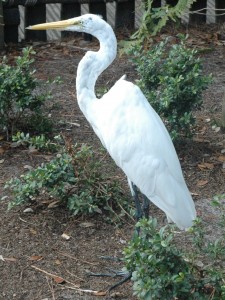Purple Gallinule
General
The Purple Gallinule (Porphyrio martinica) sometimes referred to as a ‘swamp hen,’ is a brightly colored bird that can be found gracefully walking across floating vegetation in southern and tropical marshlands.
Description
Purple Gallinules are chicken-sized birds that reach a mature length of approximately 14”, with a wingspan of 20” to 24”, and a mature weight of 7.3 oz. to 10.2 oz. They have red eyes, a short, triangular red bill with a yellow tip, and a light blu e or white frontal shield (located on the forehead.) Some of their most unique features are their tall, thin yellow legs and long toes (used to navigate across floating vegetation.) PG’s are perhaps best known for their striking coloration. Purple-blue plumage covers the head, neck, breast, short tail, and underside. The back and wings are green-blue and their undertail coverts are white. Chicks are born covered in black down. Juveniles are buff to brown in color, with some green on their backs, yellow legs, and dull facial features.
e or white frontal shield (located on the forehead.) Some of their most unique features are their tall, thin yellow legs and long toes (used to navigate across floating vegetation.) PG’s are perhaps best known for their striking coloration. Purple-blue plumage covers the head, neck, breast, short tail, and underside. The back and wings are green-blue and their undertail coverts are white. Chicks are born covered in black down. Juveniles are buff to brown in color, with some green on their backs, yellow legs, and dull facial features.
Purple Gallinule movements on land have been likened to those of a chicken while in the water, they’re said to move like a duck. Their long toes enable then to gracefully move across floating vegetation, but make it difficult for them to clamber through dense shrubs.1 While walking or swimming, they move their head and tail in a constant jerking motion. The flight of the PG has been described as labored and slow, with dangling legs. Despite this, PG’s have been known to fly great distances from their home ranges and have been sighted as far north as southern Canada and Maine.
Purple Gallinules are vocal and make squawking, cackling, and guttural grunting noises.
Habitat
 PG’s can be found in freshwater marshes, wetlands, lakes, waterways, or bayous where there is a presence of floating vegetation (such as lily pads.)
PG’s can be found in freshwater marshes, wetlands, lakes, waterways, or bayous where there is a presence of floating vegetation (such as lily pads.)
Location
They are year round residents of northern, central, and eastern-central South America, parts of Central America, southern Florida, and the Caribbean. Breeding ranges reach northward to Texas, Arkansas, the Carolinas, and the Gulf Coast. Some populations migrate short distances and winter along the Gulf Coast of the United States and in Central America.2 Although the PG is not a graceful flier, there have been sightings far from this species normal range (in the northern United States, southern Canada, Europe, and South Africa.)3
Diet
They are ground foragers whose diets consist of aquatic vegetation, grasses, seeds, fruit, water hyacinth flowers, grains, insects, and some invertebrates. They gather plant material while standing atop floating vegetation, climb brush for seeds or fruit, and collect insects off the bottom of lily pads (by rolling the edge over and holding it in place with their foot while collecting the insects with their bill.) Insects are fed to the chicks. PG’s are able to use their feet to hold food while eating.
Reproduction
Purple Gallinules breed between April and September. Nests are built using grasses and other aquatic vegetation and are attached to either a floating mat or a thicket of vegetation. Between 6 to 10 eggs are laid -one per day- that are creamy to buff with small irregular brown spots. Both the male and female incubate the eggs for 18 to 20 days. The chicks hatch over the course of 3 to 4 days, covered in black down. The chicks generally remain in the nest until all the eggs have hatched, but are able to leave the nest within a day of hatching if disturbed (already capable of swimming, diving, and running.) The chicks are fed by both parents for 8 to 9 weeks. By 7 weeks old, the chicks are capable of short flights and by 10 weeks old, they can make sustained flights (by this time the chicks have reached 1/3 their mature size.)4
Notes of Interest
There is a hunting season for PG’s in the United States; however, they are not a common game bird and by the time the season opens, local Purple Gallinule populations have often already started migrating south. For example, the hunting season in Arkansas includes a daily limit of 15 birds and lasts from September 1st through November 15th.5
1. http://www.allaboutbirds.org/guide/Purple_Gallinule/id
2. http://birds.audubon.org/birds/purple-gallinule
3. http://www.allaboutbirds.org/guide/Purple_Gallinule/id
4. http://txtbba.tamu.edu/species-accounts/purple-gallinule/
5. http://thecabin.net/sports/outdoors/2009-08-16/
http://www.allaboutbirds.org/guide/Purple_Gallinule/id
http://birds.audubon.org/birds/purple-gallinule
http://txtbba.tamu.edu/species-accounts/purple-gallinule/
http://thecabin.net/sports/outdoors/2009-08-16/
Back to birds page


